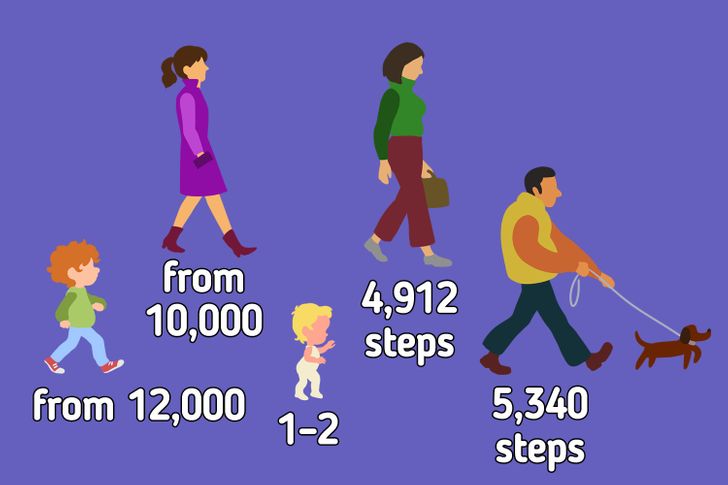Why There’s No Point in Taking 10,000 Steps Each Day
Perhaps you’ve heard that it’s necessary to take 10,000 steps each day to maintain your well-being and strong health. There are many step-o-meters, smartwatches, fitness trackers, and other applications designed to track this process and watch a person’s activity during the day. But how true is this information, and can 10,000 steps a day really improve your life?
5-Minute Crafts invites you to look at this matter from the perspective of science in order to connect all the dots.
Getting benefits from walking
Walking is one of the most beneficial forms of physical activity. It helps to maintain a healthy weight, improve cardiovascular function, reduce high blood pressure, and it also has a beneficial effect on your mood. Its main advantage is accessibility and simplicity: almost any of us can get up from the couch and walk around the neighborhood and feel the benefits of this activity.
Whether or not it’s necessary to take 10,000 steps each day

We are often recommended to take 10,000 steps a day to maintain our health — some sources advise taking at least 5,000 steps. In an experiment that lasted for 13 years, it was found that people who take at least 7,000 steps a day have a 50%-70% lower risk of dying early compared to those who take less than 7,000 steps a day. At the same time, the speed of steps taken or an increase in their number does not affect mortality. It’s assumed that after a specific moment, additional steps no longer have a positive effect.
But even such recommendations shouldn’t be taken as a mandatory norm, just as some kind of guideline. Additionally, we can pay attention to the indicators of average activities that are characteristic of people of different ages and that are based on observations made in the framework of various studies. For example, a child who is just learning to walk may, on average, take only a couple of steps a day or not take any at all. Boys and young men, ages 5 to 19, take 12,000 to 16,000 steps a day. At the same time, girls and young women are less active: they take anywhere from 10,000 to 13,000 steps per day. In another study that monitored the activity of 1,000 adults, it was found that men take an average of 5,340 steps per day, and women, 4,912 steps — although this number may be different depending on the country of residence and household habits.
In any case, in order not to turn a healthy activity into a harmful one, people should remember about restrictions, especially when trying to take on a several-day norm at once.
If for some reason, a long walk doesn’t fit in your daily schedule, activities like swimming, riding a bike, playing tennis, dancing, heavyweight lifting, and many others can become a good alternative.
How to move more during the day
- Add music. Listening to your favorite songs can make your walks more appealing. It’s not mandatory to go to a park to do it — just park your car not too far from your office and walk the rest of the way on foot. Or you can get off public transport a bit earlier than usual in order to walk 1-2 bus stops.
- Take a dog with you. If you don’t have a dog, you can sign up as a volunteer to some animal shelter where, after passing an introductory course and undergoing short training, you will be able to walk dogs. You can also join in on the daily walks of your friend who has a dog.
- Encourage your family members to join you. Instead of watching TV with your family, suggest you take a walk together.
- Add diversity to your working day. Instead of sending e-mails to your colleagues, you can walk to their working place. When having a meeting, invite them not to sit in one place but to take a walk and discuss work matters while doing so. You can also use the stairs instead of the elevator.